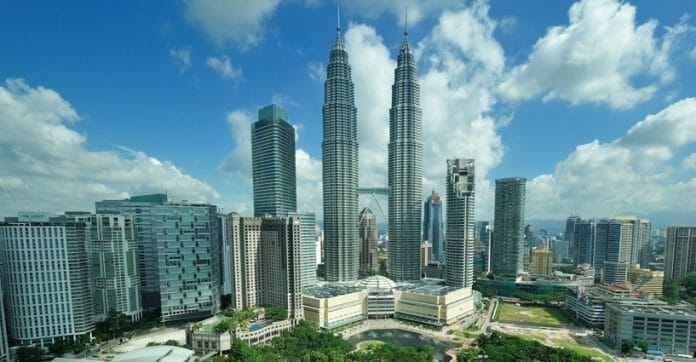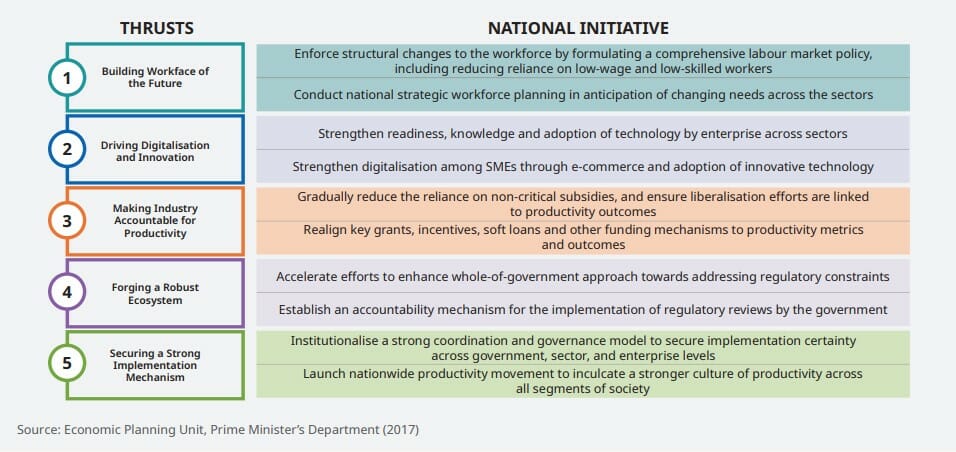In Malaysia, the pace of economic recovery has gained momentum, with a rebound in growth of 3.1% in 2021 compared to a contraction of 5.5% in 2020. The growing trend of the economy has continued into 2022 with a growth of 5% and 8.9% in the first and second quarters, respectively.
Currently, the economic recovery process is well underway where measures and strategies have to be applied towards expediting business recovery, providing a conducive business environment, facilitating trade and investment, improving labour market conditions, safeguarding households’ livelihood and inculcating sustainability principles throughout the whole spectrum of the economy.
Prioritising Government Efficiency in Boosting Malaysia’s Global Competitiveness
As aspired in the Twelfth Malaysia Plan, 2021 – 2025 (12MP), Malaysia aims to become a high-income nation by 2025 and envisages being a prosperous, inclusive and sustainable nation.
Therefore, emphasis will be placed on restoring economic growth, addressing socioeconomic challenges, ensuring balanced regional development, and enhancing the nation’s competitiveness to be economically more resilient and sustainable.
The Ministry of Finance with the Malaysia Productivity Corporation (MPC) analysed factors that drive Malaysia’s competitiveness and the Government’s efforts to address challenges that hamper productivity growth and competitiveness.
From the mid 1980’s until 2010, Malaysia recorded strong economic growth annually. This good performance prompted the World Bank in 1993 to recognise Malaysia as one of the high performing Asian economies (HPAEs).
However, while undergoing various stages of development, Malaysia remains a middle-income country with slower productivity growth, lagging behind the Asian developing economies such as Hong Kong, the Republic of Korea, Singapore and Taiwan that achieved high-income nation status during the period.
The Economic Outlook 2023 compiled by the Ministry of Finance as part of Budget 2023 cited Malaysia’s gross national income (GNI) per capita in 2021 was USD10,930, below the threshold level of USD12,695 for a high-income economy (World Bank, 2021).
Meanwhile, the COVID-19 pandemic has exposed structural vulnerabilities, highlighting the need for Malaysia to reform and rebuild to position the economy on a stronger and more sustainable footing.
Malaysia’s Position in the World Competitiveness Index
In Malaysia’s journey to become a high-income nation, issues surrounding the reallocation of economic resources, limited technology creation and structural issues in the labour market such as skills gap and low female labour force participation rate need to be addressed accordingly.
In addition, World Bank states that accelerating productivity growth is Malaysia’s central economic policy challenge and a key factor in building a more competitive economy. The report also revealed that, among others, Malaysia has a lower share of employment in the skilled category.
Further, in the input to the IMD WCY Report 2022, MPC has identified four challenges faced by Malaysia, which include:
• expanding regulatory reform initiatives to micro levels through public-private collaboration;
• enhancing technological adoption to increase productivity at the firm level;
• accelerating talent development initiatives to keep up with new and emerging job challenges and nurture a future-ready workforce; and
• strengthening productivity and competitiveness through mindset change and creativity.
Despite the challenges, Malaysia is committed to improve its performance and targets rankings under the 12MP including to reach the top 30 in the Corruption Perceptions Index and top nine in the Government Efficiency category of the IMD WCY (EPU, 2021).
In addition, Malaysia continues to pursue a target of 80% end-to-end Government online services by the year 2025.
Malaysia’s Productivity
Productivity is a cornerstone of a nation’s economic growth that measures efficiency by comparing the outputs with the inputs used for goods and services.
Productivity is closely linked to competitiveness whereby higher productivity, among others, will benefit a country in terms of expansion of capital investment thus attracting foreign investment.
Productivity will also lead to the development of personal skills which could translate to higher wages and salaries thus improving standard of livings (MPC, 2019). Realising the importance of sustaining higher productivity, under the Eleventh Malaysia Plan, Malaysia targeted labour productivity to be raised from RM77,100 per worker in 2015 to RM92,300 by 2020 (EPU, 2015).
To this note, Malaysia exceeded the target earlier in 2019, recording RM94,138 per worker. However, due to the COVID-19 pandemic, Malaysia’s productivity growth contracted by 5.3% at RM89,106 per worker in 2020. In 2021, Malaysia’s labour productivity performance started to regain the momentum, rebounding by 1.8% with a level of RM90,697 per worker.
Malaysia Productivity Blueprint (MPB) was introduced in 2017 as a strategy to raise labour productivity (EPU, 2017).
The MPB outlines five strategic thrusts to ensure holistic and systematic change across all economic sectors. Furthermore, improving productivity continues to be emphasised in the 12MP and the Shared Prosperity Vision 2030.
The 12MP has identified boosting productivity growth as one of the key priority areas and as the way forward to strengthen the macroeconomic fundamentals as well as restore the country’s growth momentum.
In this regard, labour productivity growth is expected to register at 3.6% per annum during the 12MP period.










